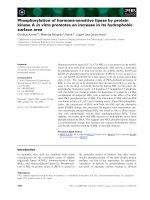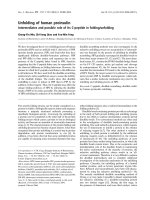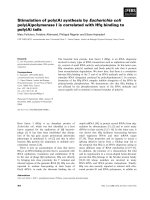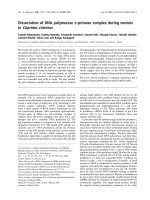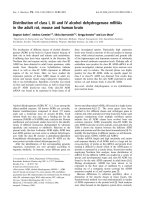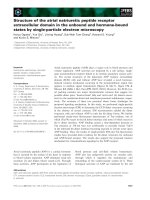Báo cáo khoa học: "Consequences of concurrent Ascaridia galli and Escherichia coli infections in chickens" doc
Bạn đang xem bản rút gọn của tài liệu. Xem và tải ngay bản đầy đủ của tài liệu tại đây (129.61 KB, 12 trang )
Permin A, Christensen JP, Bisgaard M. Consequences of concurrent Ascaridia galli
and Escherichia coli infections in chickens. Acta vet. scand. 2006, 47, 43-53. – Three
experiments were carried out to examine the consequences of concurrent infections with
Ascaridia galli and Escherichia coli in chickens raised for table egg production. Char-
acteristic pathological lesions including airsacculitis, peritonitis and/or polyserositis
were seen in all groups infected with E. coli. Furthermore, a trend for increased mortal-
ity rates was observed in groups infected with both organisms which, however, could not
be confirmed statistically. The mean worm burden was significantly lower in combined
infection groups compared to groups infected only with A. galli. It was also shown that
combined infections of E. coli and A. galli had an added significant negative impact on
weight gain.
Ascaridia galli; E. coli; interactions; free-range layer chickens
Acta vet. scand. 2006, 47, 43-54.
Acta vet. scand. vol. 47 no. 1, 2006
Consequences of concurrent Ascaridia galli and
Escherichia coli infections in chickens
By A. Permin
1
,*, J. P. Christensen
1
, M. Bisgaard
1
1
Department of Veterinary Pathobiology, The Royal Veterinary and Agricultural University,
Stigbøjlen 4, 1870 Frederiksberg C., Copenhagen, Denmark.
Introduction
Ascaridia galli and Escherichia coli are both
common causes of infections in confined as
well as in free-range poultry productions sys-
tems (Dho-Moulin and Fairbrother, 1999; Per-
min et al. 1999).
Pathogenic E. coli may cause airsacculitis, salp-
ingitis, peritonitis, polyserositis, septicemia
and other extra-intestinal diseases in chickens,
turkeys and other avian species. However, E.
coli also constitutes part of the intestinal mi-
croflora of healthy birds and most of the dis-
eases associated with E. coli are considered
secondary to environmental and host predis-
posing factors (Dho-Moulin and Fairbrother
1999). Clinical isolates of avian E. coli com-
monly belong to certain serogroups, i.e. O1, O2
and O78, and to a restricted number of clones
(White et al. 1993). Experimental infections
have shown that the air-exchange regions of the
lungs and the airsacs are important sites of en-
try of E. coli into the bloodstream of birds dur-
ing the initial stages of infection and that resis-
tance to phagocytosis may be an important
mechanism in the development of the disease
(Gross 1990). It has also been demonstrated
that F1 fimbriae are expressed in the respiratory
tract, whereas P fimbriae are expressed in the
internal organs of infected chickens (Vidotto et
al. 1990). Unambiguous virulence factors asso-
ciated with E. coli infections in avian species,
remain to be identified. Diagnosis of E. coli in-
fections is based on the clinical picture, lesions
and isolation of E. coli (Dho-Moulin and Fair-
brother 1999).
A. galli may cause anorexia, weight loss, haem-
orrhages in the intestinal mucosa, obstruction
* Corresponding author. Tel: +45 35282748. Fax: +45 35283762. E-mail: (A. Permin).
of the intestinal lumen, altered hormone level
and eventually death (Ackert 1931, Ikeme 1971,
Roepstorff et al. 1999) in a wide range of avian
species. The life cycle of A. galli is direct with
a prepatent time of minimum 28 days under
temperate climatic conditions (Permin et al.
1998). After ingestion of the infective egg, the
egg hatches in the small intestine where the
larva embeds in the mucosal layer of the duo-
denum for a varying period of 3- 56 days de-
pending on age and immunity of the bird (Herd
and McNaught 1975). After maturation of the
worm, it migrates to the intestinal lumen where
it lives from intestinal contents and occasion-
ally from host blood. The mature worms copu-
late and might start producing eggs after 28
days. Diagnosis of A. galli is based on faecal
isolation of parasite eggs or direct identification
of adult worms in the intestine (Permin and
Hansen 1998).
Few pathogen interaction studies have been car-
ried out in poultry. Okulewicz and Zlotorzycka
(1985) showed that A. galli exerted an inhibiting
effect on the natural bacterial micro flora of the
intestine of hens. The opposite situation, where
the bacterial flora of the intestine inhibited the
establishment of A. galli was demonstrated by
Stefanski and Przyjakowski (1967). Chadfield et
al. (2001) showed an interaction between the in-
testinal flora and A. galli, where the bacterium
Salmonella enteriditis was incorporated into the
eggs of A. galli. This finding, however, is in con-
trast to the finding of Baron et al. (1960), where
the eggs of A. galli were found to be sterile. To
the knowledge of the authors nobody has exam-
ined the interaction between E. coli and A. galli
infections in chickens. Consequently this study
has been designed to investigate the possible ef-
fect of two common concurrent infections; A.
galli super imposed with E. coli and vice versa,
on establishment of the respective infections,
pathological lesions, mortality and impact on
selected production parameters.
Materials and methods
Experimental animals
Female Lohman Brown chickens were used for
all experiments. The chickens were purchased
as one-day-old chicks and kept for one week in
a confined parasite free environment until the
experiment. The chickens were given a com-
mercial feed containing 20% protein and water
ad libitum. The chickens were kept in one flock
until infection whereafter they were placed in
separate houses.
Infection material
A clinical nalidixic_acid_resistant O78 E. coli-
isolate originating from broilers suffering from
respiratory distress (difficulties in breathing)
was grown overnight in an enrichment media
(LB-broth) to reach the desired infection dose
(Lee and Arp 1998). The number of bacteria pr.
ml (cfu) was determined by spectophotometry
and plate counts.
A. galli eggs were isolated from mature female
worms obtained from layers and embryonated
in 0.1N sulphuric acid according to the method
described by Permin et al. (1997b).
Experimental design
In total, three experiments were carried out.
The first experiment was conducted to deter-
mine the route and dose of the E. coli having
clinical impact without killing all chickens, a
prerequisite for the following two trials. The in-
fection dose and infection route of A. galli was
set to be 500 embryonated eggs given as a sin-
gle oral infection in all three experiments ac-
cording to previous studies by Permin et al.
(1997a). The last two experiments were de-
signed as 2 x 2 cohort studies, i.e., groups with
or without A. galli and E. coli infections in-
cluding a control group (Thrusfield 1995).
44 A. Permin et al.
Acta vet. scand. vol. 47 no. 1, 2006
Determination of dose and infection route of E.
coli
Fifty-two one-week-old chickens were pur-
chased and were kept for seven days to acclima-
tise in the new environment. The chickens were
divided into 9 groups of which 7 groups each
consisted of 6 animals and 2 groups of each 5
animals. The animals were infected as given in
Table 1. The primary infection with A. galli or
E. coli took place on day 0 of the experiment.
The secondary infection was carried out seven
days after the first infection. All chickens were
killed on day 14 and subjected to post mortem
examinations (Permin and Hansen 1998).
Final experiments
Based on the results of the first experiment, two
further experiments were set up, each with six
groups. In total 299 four-week-old Lohman
Brown female chickens were used for the ex-
periments. The infection dose of E. coli was set
to be 10
8
cfu in the two experiments, given as
either an oral or a tracheal infection. In all ex-
periments A. galli and E. coli were given either
as single or combined infections. In the case of
combined infections the chickens were inocu-
lated with an interval of 7 days between the two
infections. In the second experiment the ani-
mals were followed for 14 days after the second
infection, whereas the animals in the third ex-
periment were followed 4 weeks after the sec-
ond infection. Group distributions and inocula-
tion schemes are given in Tables 2 and 3.
Parameters measured
All chickens were weighed just as clinical signs
were recorded. Furthermore, re-isolation and
counting of the nalidixic-acid-resistant E. coli
(Lee and Arp 1998) and A. galli larvae/adults
(Permin and Hansen 1998) was carried out on
all animals dying during the experiment and at
the end of the experiment. Likewise, pathologi-
cal lesions, if any, were recorded on all chickens.
Statistical analyses
All data were stored in the statistical pro-
gramme GraphPad Prism (GraphPad Software
Incorporated 2000). One-way analysis of vari-
ance (ANOVA), chi-square analysis (
⑂⑂
2
-analy-
sis) or Students t-test were used to analyse the
data.
Results
Determination of dose and infection route
of E. coli
Pathological lesions associated with an E. coli
infection were seen in the group given E. coli by
tracheal route with 10
8
cfu and in the groups in-
fected with A. galli combined with a secondary
E. coli infection given by tracheal route with a
dose of 10
4
or 10
8
cfu. Pathological lesions
were observed in four, three and two chickens
respectively in these groups (Table 1). How-
ever, E. coli could only be re-isolated from
three of these animals. One animal died in the
group infected with A. galli and E. coli given by
tracheal route with 10
4
cfu while two animals
died in the group given only a tracheal oral dose
of 10
8
E. coli. These three animals all tested
positive for E. coli. A chi-square analysis
showed no significant difference in mortality
rates between the groups (p>0.05).
A. galli larvae were recovered from all four
groups infected with the parasite. An analysis
of variance showed that the worm burdens were
not significantly different between groups
(p>0.05).
The animals were weighed four times during
the first experiment. The mean weight gains are
given in Figure 1. One week after the first in-
fection with either A. galli or E. coli differences
were seen between the infected groups when
compared to the control group (p<0.05), but
there was no significant difference between the
infected groups. At slaughter (fourth weighing)
an analysis of variance showed that the group
infected with A. galli and subsequently with E.
Ascaridia galli and Escherichia coli infections in chickens 45
Acta vet. scand. vol. 47 no. 1, 2006
coli given as a tracheal infection with 10
8
bac-
teria had a significantly lower (p<0.05) weight
gain compared to all the other groups. But also
the groups infected with E. coli given as an oral
or tracheal infection with a dose of 10
8
bacteria
and the group given A. galli and subsequently
E. coli with 10
4
bacteria had a significantly
lower weight gain (p<0.05) at time of slaughter
compared to the control group.
Based upon the overall results obtained in one-
week-old chickens, which are more susceptible
to E. coli infections, 10
8
E. coli was chosen as
46 A. Permin et al.
Acta vet. scand. vol. 47 no. 1, 2006
Ta ble 1. Infection groups used for the determination of dose and infection route of E. coli
Group Type of infection Group size Pathological findings
Ag+Ec40 A. galli (primary infection) given as oral 5 No pathological findings
dose of 500 embryonated eggs + E. coli
(secondary infection) given as oral dose
of 10
4
cfu.
Ag+Ec4T A. galli (primary infection) given as oral 6 1 animal with polyserositis, †
dose of 500 embryonated eggs + E. coli 1 animal with pericarditis and
(secondary infection) given as tracheal doublesided pneumonia
dose of 10
4
cfu.
Ag+Ec8O A. galli (primary infection) given as oral No pathological findings
dose of 500 embryonated eggs + E. coli
(secondary infection) given as oral dose
of 10
8
cfu.6
Ag+Ec8T A. galli (primary infection) given as oral 6 1 animal with fibrinopurulent
dose of 500 embryonated eggs + E. coli polyserositis
(secondary infection) given as tracheal dose 1 animal with pericarditis and
of 10
8
cfu. purulent double sided
pneumonia
1 animal with pericarditis and
double sided airsacculitis
Ec4O E. coli given as oral dose of 10
4
cfu. 5 No pathological findings
Ec4T E. coli given as tracheal dose of 10
4
cfu. 6 No pathological findings
Ec8O E. coli given as oral dose of 10
8
cfu. 6 No pathological findings
Ec8T E. coli given as tracheal dose of 10
8
cfu. 6 2 animals with pericarditis and
double sided airsacculitis
1 animal with polyserositis
and right sided pneumonia, †
1 animal with polyserositis
and double sided pneumonia,†
Control Uninfected control 6 No pathological findings
† the animal died during the first week of the infection trial.
the dose of infection in both oral and tracheal
infections and four-week-old chickens were
used instead (Dho-Moulin and Fairbrother
1999).
Final experiments
In the second experiment A. galli was given as
the primary infection followed by E. coli. The
results of the second experiment are outlined in
Table 2. Pathological lesions consistent with E.
coli infections were seen in the group infected
with A. galli followed by E. coli given as a tra-
cheal dose of 10
8
cfu. in addition to the two
groups infected by oral or tracheal route with
only E. coli. Pathological lesions were observed
in four, one and four chickens in these groups,
respectively. Pathological lesions were not seen
in the group infected with only A. galli or in the
groups infected with first A. galli and subse-
quently with E. coli given as an oral dose of 10
8
cfu.
Mortality was encountered in the groups in-
fected with E. coli given as an oral or tracheal
infection and in the group with combined A.
galli and tracheal E. coli infection. Mortality
due to cannibalism was seen in the control
group. A chi-square analysis for differences in
mortality showed no significant differences be-
Ascaridia galli and Escherichia coli infections in chickens 47
Acta vet. scand. vol. 47 no. 1, 2006
Ta ble 2. Number of chickens, parasitic (A. galli), bacterial (nalidixic-acid-resistant O78 E. coli) and patholog-
ical findings of second experiment with primary A. galli infections superimposed by secondary E. coli infections.
Group Type, route and dose Group size No of dead Post-mortem findings at slaughter
of infection animals
during
experiment Pathological Worm Re-
changes burden isolation
(±S.D.) of E. coli
Ag Oral 500 A. galli eggs 25 0 25 neg. 5.6±11. 25 neg.
0
Ag+Ec8O Oral 500 A. galli eggs + oral 37 0 37 neg. 14.0±1 37 neg.
E. coli with 10
8
cfu 8.0
Ag+Ec8T Oral 500 A. galli eggs + 38 1
1
1 PS + PC + 10.0±1 37 neg.
tracheal E. coli with 10
8
cfu AS, 1 FPPS 4.0
+LNC, 1
FPPC, 34
neg.
Ec8O Oral E. coli with 10
8
cfu 25 1
2
24 neg. 0 24 neg.
Ec8T Tracheal E. coli with 10
8
cfu 25 4
3
21neg. 0 21neg.
Control Uninfected control 25 3
4
22 neg. 0 22 neg.
AS=airsacculitis; FP=fibrinopurulent; L=liver; neg=negative; NC=necrosis; PC=pericarditis; PS=polyserositis; SP=spleen;
1
One animal died after the 2nd infection testing positive for a nalidixic-acid-resistant E. coli in liver and spleen and with
necrosis of the spleen.
2
One animal died after first infection with polyserositis, but was negative for bacteriology.
3
Four animals died after the infection with E. coli; three animals tested positive for a nalidixic-acid-resistant E. coli in liver
and spleen. Of these two animals had fibrinopurulent pericarditis, one had polyserositis and the remaining E. coli negative
chicken had fibrinopurulent salpingitis.
4
Three animals died due to cannibalism, but had no other pathological findings.
tween the groups (p>0.05). Pure isolates of E.
coli were obtained from liver and spleen from
the group with combined A. galli and tracheal
E. coli infection and in the group infected with
only tracheal E. coli. At slaughter, A. galli lar-
vae were isolated from the three groups initially
infected with A. galli. A significantly lower
worm burden was seen in the A. galli group
compared to the combined groups (p<0.01). It
was not possible to recover the nalidixic-acid-
resistant O78 stain used for inoculation of the
birds at time of slaughter.
The mean weight gains for all groups are given
in Figure 2. After the first infection with A. galli
until the second infection a slight weight de-
pression was seen in all groups including the
control group. An analysis of variance between
all groups at time of the first and second infec-
tion showed no significant difference between
the groups (p>0.05). However, after the second
infection (and for the remaining time of the ex-
periment), with E. coli given as a tracheal or
oral infection, a significantly lower weight gain
was seen in these groups compared to all other
groups (p<0.05).
In the third experiment E. coli was given as the
primary infection followed by A .galli. The re-
sults of the third experiment are outlined in
Table 3. Pathological changes due to E. coli
were only found in the two groups given E. coli
by tracheal route, one of which was additionally
infected with A. galli. In this group seven ani-
mals died after the secondary infection with A.
galli, while only six chickens died in the group
infected tracheally with E. coli. All were posi-
tive for E. coli and had extensive pathological
48 A. Permin et al.
Acta vet. scand. vol. 47 no. 1, 2006
Ta ble 3. Number of animals, parasitic (A. galli), bacterial (nalidixic-acid-resistant O78 E. coli) and patholog-
ical findings of third experiment with primary E. coli infection superimposed by secondary A. galli infection
Group Type, route and dose Group size No of dead Post-mortem findings at slaughter
of infection animals
during
experiment Pathological Worm Re-
changes burden isolation
(±S.D.) of E. coli
Ag Oral 500 A. galli eggs 20 0 20 neg. 0.8±1.4 20 neg.
Ec8O+Ag Oral E. coli with 10
8
cfu + oral
500 A. galli eggs 21 0 21 neg. 0.3±0.5 21 neg
Ec8T+Ag Tracheal E. coli with 10
8
cfu +
oral 500 A. galli eggs 21 7
1,4
14 neg. 0.1±0.3 14 neg.
Ec8O Oral E. coli with 10
8
cfu 21 0 21 neg. 0 21 neg.
Ec8T Tracheal E. coli with 10
8
cfu 21 6
2,4
15 neg. 0 15 neg.
Control Uninfected control 20 0 20 neg. 0
3
20 neg.
1
Seven animals died after the second infection with A. galli. All were positive for a nalidixic_acid_resistant O78 E. coli and
had extensive pathological changes, all with airsacculitis and fibrinopurulent pericarditis.
2
Six animals died after the first infection with E. coli. All were positive for a nalidixic_acid_resistant O78 E. coli and five
chickens had pathological with airsacculitis and fibrinopurulent pericarditis. One chicken had no pathological changes.
3
Few larvae were recovered in the uninfected groups.
4
Significantly more animals died compared to the remaining groups.
changes corresponding to E. coli infections. A
⑂⑂
2
-analysis showed that a significantly higher
number of animals died in these two groups
compared to the others (p=0.056).
At slaughter larvae were recovered from all
groups infected with A. galli. A t-test revealed
that there were significantly lower worm bur-
dens in the combined infection groups com-
pared to the group only infected with A. galli
(p<0.05). The nalidixic-acid-resistant O78
strain used for inoculation of the birds was not
recovered at the time of slaughter.
The mean weight gains are given in Figure 3. A
weight depression was seen for the two groups
infected with E. coli given as a tracheal primary
infection. Additional weight loss was observed
for the group infected additionally with A. galli.
An analysis of variance between all groups at
the time of the first infection showed no signif-
icant difference in weight gain between the
groups (p>0.05). However, after the infection
with E. coli there was a significant difference
between the groups infected first with E. coli by
tracheal route and the group infected secondly
with A. galli (p<0.05) compared to the other
groups. The weight gain for the group infected
with only with E. coli by tracheal route was sig-
nificantly lower (p<0.05) two weeks after infec-
tion. At the time of slaughter there was a sig-
nificant difference between the group tracheally
infected with E. coli followed by A. galli com-
pared to the other groups (p<0.05) whereas the
Ascaridia galli and Escherichia coli infections in chickens 49
Acta vet. scand. vol. 47 no. 1, 2006
age in days
1 7 (1st infection) 14 (2nd infection) 21
0
50
100
150
200
250
300
350
Ag+Ec4O Ag+Ec4T Ag+Ec8O
Ag+Ec8T Ec4O Ec4T
EcO8 Ec8T Control
Figure 1. Average weight gain of the 9 groups in experiment 1 (determination of dose and infection route of
E. coli) where Ag = A. galli, Ec= E. coli, O=oral, T=tracheal, 4=10
4
cfu and 8=10
8
cfu.
single infected E. coli group had a weight gain
similar to the other groups (p>0.05).
Discussion
In total, three experiments were carried out to
examine the effect of various combinations of
A. galli and E. coli infections in growing chick-
ens of layer type. Characteristic pathological le-
sions due to E. coli were seen in all the groups
tracheally infected with E. coli as previously
described by Dho-Moulin and Fairbrother
(1999) and Nakamura et al. (1985), while le-
sions were absent in those inoculated orally.
Pathological lesions were not observed in rela-
tion to the A. galli infection. This is presumably
due to the rather low worm burdens observed in
the chickens (Ikeme 1971, Permin et al. 1997a).
The combined infections of E. coli and A. galli
did not produce more pathological lesions,
which is unexpected as simultaneous parasitic
infections often create more severe pathologi-
cal lesions (Christensen et al. 1987). However,
a trend for increased mortality rates was seen in
the groups infected with the two pathogens, but
it was not confirmed statistically.
Significantly different worm burdens were iso-
lated from the intestinal tract of the A. galli and
E. coli infected groups compared to the A. galli
infected groups. With A. galli given first fol-
lowed by an oral or a tracheal E. coli infection,
significantly higher worm burdens were ob-
served in both groups. Johnson and Reid (1973)
50 A. Permin et al.
Acta vet. scand. vol. 47 no. 1, 2006
age in days
21 28 (1st inf.) 35 (2nd) 42 49 56 63 70
0
100
200
300
400
500
Ec8O+Ag Ec8O Ag
Ec8T+Ag Ec8T Control
Figure 2. Weight gain in final (2nd experiment) where A. galli was given as the primary infection and E. coli
was given as the second infection and where Ag = A. galli, Ec= E. coli, O=oral, T=tracheal and 8=10
8
cfu.
had similar results on the establishment of A.
galli when chickens were infected with Bacillus
subtilis and B. cereus. With a tracheal or oral E.
coli infection given first followed by an A. galli
infection the opposite situation was observed.
Other studies have shown, that in antibiotic-
sterilized chickens, the presence of B. mesen-
tericus, B. megatherium and Lactobacillus aci-
dophilus in the intestine inhibited the
establishment of A. galli (Stefanski and Przyja
kowski 1967) whereas Okulewicz and Zlotorzy-
cka (1985) showed that A. galli inhibited the
natural bacterial micro flora of the intestine of
hens. The mechanisms for these phenomena are
not known, but possibly related to the develop-
ment of immunity. A recent paper by Pritchard
and Brown (2001) has indicated that although
cellular response mechanisms of bacteria and
parasites are related to each their pathway (Th2
for parasites and Th1 for bacteria) there is a bal-
ance between the two pathways. Thus a parasite
infection might favour the Th2 cell develop-
ment and indirectly suppress the establishment
of bacteria, or vice-versa.
Furthermore, lower worm burdens were de-
tected in the third experiment which ran for ad-
ditional weeks. Similar observations were made
by Tongson and McCraw (1967) where a non-
specific age related immunity developed in
growing chickens around the age of 3 months.
The mechanism could be a self-cure mecha-
nism as recently described in chickens in rela-
Ascaridia galli and Escherichia coli infections in chickens 51
Acta vet. scand. vol. 47 no. 1, 2006
age in days
21 28 (1st inf.) 35 (2nd inf.) 42 49 56
0
50
100
150
200
250
300
350
400
Ag+Ec8O Ec8O Ag
Ag+Ec8T Ec8T control
Figure 3. Weight gain in final experiment (3rd experiment) where E. coli was given as the primary infection and
A. galli was given as the second infection and where Ag = A. galli, Ec= E. coli, O=oral, T=tracheal and 8=10
8
cfu.
tion to A. galli (Permin and Ranvig 2001). Balic
et al. (2000) discussed the expulsion of tri-
chostrongyle nematodes after primary infec-
tions in rodents speculating that the mechanism
behind is genetically related as also described
by Behnke et al. (1992). The expulsion is
mainly seen in rodents and not in larger animals
(Balic et al. 2000).
The nalidixic-acid-resistant E. coli strain was
only isolated from the chickens which died dur-
ing the experiment and not from any of the ani-
mals at slaughter. Similar findings have been re-
ported by Leitner and Heller (1992), who could
not isolate an orally inoculated nalidixic-acid-
resistant O78 from the trachea or from the
blood in stressed turkeys. However, in orally in-
fected broiler chickens, stress resulted in bac-
teremia and mortality.
In the experiments significantly lower weight
gains were seen in the groups given E. coli as a
tracheal infection. Weight depression as a result
of tracheal E. coli infections is in accordance
with the findings of other researchers (Dho-
Moulin and Fairbrother 1999). It was further
shown that the combined infection with A. galli
had a significant added negative impact on
weight gain. Interestingly a primary infection
with A. galli followed by an oral infection with
E. coli also had a significantly negative impact
on the weight gain.
Young birds (4-8 weeks) may have a brief pe-
riod of anorexia and depression after infection
with E. coli followed by acute septicaemia with
mortality. However, weight depression was also
seen after an oral E. coli infection when A. galli
eggs were given as the primary infection. This
may be related to damage of the intestinal mu-
cosa leading to loss of blood and, probably, es-
tablishment of a secondary infection such as E.
coli (Herd and McNaught 1975). Likewise, in-
fections with A. galli have been reported to
cause reductions in the growth rate, weight loss
and mortality in broilers (Ackert and Herrick
1928, Reid and Carmon 1958, Ikeme 1971, He
et al. 1990). The severity of the intestinal le-
sions may depend on the number of worms es-
tablished in the intestine (Ikeme 1971). How-
ever, in this study only moderate weight losses
were seen due to the parasite and only in the
very young birds (1-3 weeks) whereas the older
birds apparently were able to compensate for
the infection. This is in contrast to earlier find-
ings (Ackert and Herrick 1928, Reid and Car-
mon 1958). Permin and coworkers (unpub-
lished) have observed similar findings in
growing chickens where the animals apparently
compensated for the loss due to the parasites by
an increased feed intake.
The findings of this study indicate a negative re-
lationship between concurrent infections of E.
coli and A. galli. The mechanisms behind the ob-
served relationship are not known, but might be
related to immune mechanisms (Pritchard and
Brown 2001). Leitner and Heller (1992) investi-
gated the potential of pathogenic E. coli to pene-
trate the bloodstream via the intestinal mucosa in
normal and stressed turkeys and chickens, but
did not examine this in relation to stress caused
by parasites. Their studies showed that, in orally
infected turkeys, the pathogenic bacteria (a
nalidixic-acid-resistant O78) remained in the in-
testine where it replaced 10% to 50% of the na-
tive coliform flora. But in orally infected broiler
chickens, stress resulted in bacteremia and mor-
tality. In our study significant weight depressions
were seen in the orally infected chickens, which
indicates that A. galli, when given as a primary
infection, has an damaging effect on the intesti-
nal mucosa (Herd and McNaught 1975) en-
abling E. coli to establish when it is given as an
oral infection. However, an increased mortality
was not seen. An additional effect of A. galli was
seen in the group secondarily infected with A.
galli. This could be related to an immunosup-
pressive effect of A. galli (Malviya et al. 1988,
Sharma 1997, Roepstorff et al. 1999).
52 A. Permin et al.
Acta vet. scand. vol. 47 no. 1, 2006
Conclusion
In conclusion combined infections of A. galli
and E. coli can have a significant impact on
confined and free-range chickens keeping in
mind that both infections are common in such
production systems. Further studies are needed
in order to determine the underlying mecha-
nisms of combined infections of A. galli and E.
coli in growing and adult chickens.
Acknowledgements
We would like to thank Margrethe Pearman, Rikke
Frahm Lundvig, Pernille Ginsbo, Pia Mortensen,
Stina Holm, Niels Midtgaard, Jørgen Olesen, Johnny
Jensen, Thomas Bernau Kristensen and Rene Bülow
for technical assistance during the experiments. Fi-
nancial support by the Council for Development Re-
search (Danida) through the project “Multiple infec-
tions in free-range poultry” is highly appreciated. All
experiments complied with current regulations for
the use of experimental animals in Denmark.
References
Ackert JE: The morphology and life history of the
fowl nematode Ascaridia lineata (Schneider).
Parasitol. 1931, 23, 360-379.
Ackert JE, Herrick CA: Effects of the nematode As-
caridia lineata (Schneider) on growing chickens.
J. Parasitol. 1928, 15, 1-15.
Balic A, Bowles VM, Meeusen EN: Cellular profiles
in the abomasal mucosa and lymph node during
primary infection with Haemonchus contortus in
sheep. Vet. Imm. Immunopathol. 2000, 75, 109-
120.
Baron RR, Hansen MF, Lord TH: Bacterial flora of
the roundworm Ascaridia galli (Schrank) and its
relationship to the host flora. Exp. Parasitol. 1960,
9, 281-292.
Behnke JM, Barnard CJ, Wakelin D: Understanding
chronic nematode infections: evolutionary con-
siderations, current hypotheses and the way for-
ward. Int. J. Parasitol. 1992, 22, 861-907.
Chadfield MS, Permin A, Nansen P, Bisgaard M: In-
vestigation of the parasitic nematode Ascaridia
galli as a potential vector for Salmonella dissem-
ination in broiler poultry. Parasitol. Res. 2001, 87,
317-325.
Christensen N, Nansen P, Fagbemi BO, Monrad J:
Heterologous antagonistic and synergistic inter-
actions between helminths and between
helminths and protozoans in concurrent experi-
mental infections of mammalian hosts. Parasitol.
Res. 1987, 73, 387-410.
Dho-Moulin M, Fairbrother JM: Avian pathogenic
Escherichia coli (APEC). Vet. Res. 1999, 30,
299-316.
Gross WB: Factors affecting the development of res-
piratory disease complex in chickens. Avian Dis.
1990, 34, 607-610.
He S, Susilowati VEHS, Purwati E, Tiuria R: An es-
timate of meat production loss in native chicken
in Bogor and its surrounding district due to gas-
trointestinal helminthiasis. Proceedings of the 5th
National Congress of Parasitology. East Java, In-
donesia, 1990, 57 p.
Herd RP, McNaught DJ: Arrested development and
the histotropic phase of Ascaridia galli in the
chicken. Int. J. Parasitol. 1975, 5, 401-406.
Ikeme MM: Observations on the pathogenicity and
pathology of Ascaridia galli. Parasitol. 1971, 63,
169-179.
Johnson J, Reid WM: Ascaridia galli (nematoda):
Development and survival in gnotobiotic chick-
ens. Exp. Parasitol. 1973, 33, 95-99.
Lee MD, Arp LH: Colibacillosis. In Swayne, D.E.,
Glisson, J.R., Jackwood, M.W., Pearson, J.E. and
Reed, W.M. (Eds.), A Laboratory Manual for the
Isolation and Identification of Avian Pathogens
4th edn. The American Association of Avian
Pathologists, 1998, pp. 14-16.
Leitner G, Heller ED: Colonization of Escherichia
coli in young turkeys and chickens. Avian Dis.
1992, 36, 211-220.
Malviya MC, Dwivedi P, Varma TK: Effect of irradi-
ated Ascaridia galli eggs on growth and cell-me-
diated immune responses in chickens. Vet. Para-
sitol. 1988, 28, 137-141.
Nakamura K, Maecla M, Imada Y, Imada T: Pathol-
ogy of spontaneous colibacillosis in a broiler
flock. Vet. Pathol. 1985, 22, 592-597.
Okulewicz A, Zlotorzycka J: Connections between
Ascaridia galli and the bacterial flora in the intes-
tine of hens. Ang. Parasitol. 1985, 26, 151-155.
Permin A, Bojesen M, Nansen P, Bisgaard M, Frand-
sen F, Pearman M: Ascaridia galli populations in
chickens following single infections with differ-
ent dose levels. Parasitol. Res. 1997a, 83, 614-
617.
Permin A, Pearman M, Nansen P, Bisgaard M, Frand-
sen F: An investigation on different media for
embryonation of Ascaridia galli eggs.
Helminthologia 1997b, 34, 75-79.
Ascaridia galli and Escherichia coli infections in chickens 53
Acta vet. scand. vol. 47 no. 1, 2006
Permin A, Hansen JW: Epidemiology, diagnosis and
control of poultry parasites. Rome, Italy: Food
and Agriculture Organisation, 1998, pp. 74-105,
111-118.
Permin A, Nansen P, Bisgaard M, Frandsen F: Inves-
tigations on the infection and transmission of As-
caridia galli in free range chickens kept at differ-
ent stocking rates. Avian Pathol. 1998, 27 (4),
382-389.
Permin A, Bisgaard M, Frandsen F, Pearman M, Kold
J, Nansen P: The prevalence of gastrointestinal
helminths in different poultry production sys-
tems. Brit. Poult. Sci. 1999, 40, 439-443.
Permin A, Ranvig H: Genetic resistance in relation to
Ascaridia galli in chickens. Vet. Parasitol. 2001,
102(1-2), 101-111.
Pritchard DI, Brown A: Is Necator americanus ap-
proaching a mutualistic symbiotic relationship
with humans? Trends in Parasitol. 2001, 17, 169-
172.
Reid WM, Carmon JL: Effects of numbers of As-
caridia galli in depressing weight gains in chick-
ens. Trop. Ani. Health Prod. 1958, 44, 183-186.
Roepstorff A, Nørgaard-Nielsen G, Permin A, Simon-
sen HB: Male behaviour and male hormones in
Ascaridia galli infected hens. Proceedings of the
17th International Conference of the World Asso-
ciation for the Advancement of Veterinary Para-
sitology, Copenhagen, Denmark, 1999, p d5.02.
Sharma JM: The structure and function of the avian
immune system. Acta Vet. Hun. 1997, 45, 229-
238.
Stefanski W, Przyjakowski Z: Nouvelles recherches
sur l’influence de la flora bactérienne sur l’étab-
lissement des helminthes dans leurs hôtes. Acta
Parasitol. Pol. 1967, 15, 285-287.
Tongson MS, McCraw BM: Experimental ascaridia-
sis: Influence of chicken age and infective egg
dose on structure of Ascaridia galli populations.
Exp. Parasitol. 1967, 21, 160-172.
Thrusfield M: Veterinary Epidemiology (2nd edn).
Oxford: Blackwell Science, 1995.
Vidotto M, Moeller EE, de Freitas JC, Alfieri AA,
Guimares IG, Santos DS: Virulence factors of
avian Escherichia coli. Avian Dis. 1990, 34, 531-
538.
White DG, Dho-Moulin M, Wilson RA, Whittam TS:
Clonal relationships and variation in virulence
among Escherichia coli strains of avian origin.
Micro. Pathogen. 1993, 14, 399-409.
54 A. Permin et al.
Acta vet. scand. vol. 47 no. 1, 2006
(Received 2005; accepted January 2, 2006).
Reprints may be obtained from: A. Permin, Danish Toxicology Centre, Kogle Allé 2, DK-2970 Hørsholm, Denmark.
* Corresponding author. Tel: +45 45652370. Fax: +45 45762455. E-mail: (A. Permin).


